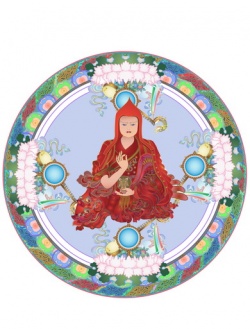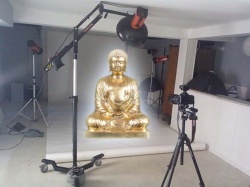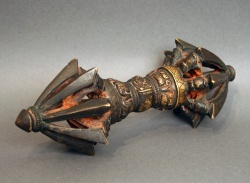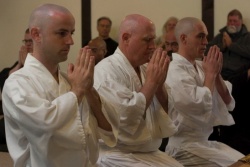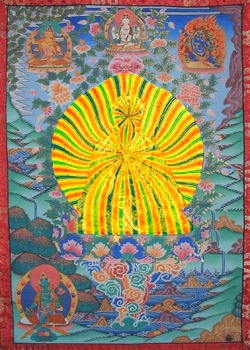The Karmapa Controversy
Unlike the dispute over Dorje Shugden, which has seen news articles examining both sides of the Dalai Lama's ban, few writers outside of India have seriously investigated the dispute over the identity of the current Karmapa. The four books published in 2003 and 2004 on the Karmapa have all supported the boy chosen by the Dalai Lama without questioning the basic assumption of the Tibetan leader's position -- namely, that he has the authority to choose the Karmapa. This has prevented these writers from paying enough attention to the most dramatic events of the controversy, particularly the violent takeover of the Karmapa's Rumtek monastery in 1993.
The Karmapa story can be confusing, and it is difficult to find the facts buried in the mountains of rhetoric built by each side in the controversy. In general, Western journalists tend to rely on one main source for information and analysis about Tibetan Buddhism, the Dalai Laina himself. In the case of the Karmapa controversy, faced with the daunting task of understanding Tibetan religious politics and sectarian rivalries, it is understandable that writers would seek clarity from a trusted source. As a result, many have allowed themselves to be guided by the Dalai Lama's press office on the complex issue.
While this has simplified research for reporters, relying on the Dalai Lama's administration for information about the Karmapa has prevented writers from getting the full story, for one simple reason. In this particular case, the Dalai Lama is not an impartial arbiter of a dispute among two groups of Tibetan lamas. Instead, as in the ban on Dorje Shugden, the Tibetan leader is a party himself to the dispute, since he has given his official support to one of the candidates for the position of seventeenth Karmapa.
The Tibetan leader's word has been sufficient evidence for many writers outside of India to declare the controversy dead. If the Dalai Lama has recognized one boy as the Karmapa, then what need of further discussion? Surely, the lamas who persist in supporting the other boy, known as Trinley Thaye Dorje, must have little merit to their case. Accordingly, hundreds of newspaper and magazine articles published in the West, along with the four recent hooks, have accepted Ogyen Trinley as the Karmapa. Though writers often cite other reasons, their primary rationale for accepting the one candidate over the other is usually that the Dalai Lama has recognized him.
Yet, in India, where most exiled Tibetans live, the controversy continues to rage. Interestingly, the Indian press has accorded credence to both Karmapa candidates. This book will examine press coverage of various events in the Karmapa story to highlight the contrast between Indian and Western reporting. This may encourage us to question the accuracy of the information that we in the West have received about Tibetan Buddhism in general.
To further highlight the difference between opinion in India and in the West on the Karmapa, the Indian government has shown suspicion of the Dalai Lama's candidate Ogyen Trinley, restricting his travels and limiting what his chief supporter in the Karma Kagyu, Tai Situ Rinpoche, can say about the controversy.
Meanwhile, the other Karmapa candidate Thaye Dorje has been able to travel freely in India and abroad. And after lamas involved in the dispute began to bring cases to the Indian court system, particularly in a property rights suit over Rumtek monastery filed by Thaye Dorje's supporters, judges have mostly ruled in favor of Thaye Dorje's party. If anything, opinion in India, both official and unofficial, appears to be running in favor of Thaye Dorje over the Dalai Lama's choice Ogyen Trinley. The important exception is Sikkim, where, as we will see, Rumtek monastery is located and where Ogyen Trinley enjoys significant support among leading families and in the local press.
The Dalai Lama's main rival on the Karmapa issue, Shamar Rinpoche, agrees with the followers of Dorje Shugden that there is a problem of religious freedom among exiled Tibetans. "The Dalai Lama asks that Tibetans have religious freedom in China," Shamar told me, "but unfortunately, His Holiness has not respected the religious freedom of Tibetans in exile to follow the traditions of their own religious lineages." Yet, Shamar has resisted allying himself with the advocates for Dorje Shugden, since he is uncomfortable with their high-profile and often acrimonious protests against the Dalai Lama. "I have always supported His Holiness Dalai Lama in every way, on freedom for Tibet, on spreading Buddhism around the world, and on human rights," Shamar said. "Only on one issue do I disagree with the Dalai Lama: choosing the reincarnation of the Karmapa."
Born in 1952, Shamar is the fourteenth incarnation in a line of tulkus going back to the thirteenth century. The first Shamarpa Drakpa Sengye (1283-1349) was a student of the third Karmapa Rangjung Dorje (1284-1339). For the next ten centuries, the Karmapa and Shamarpa worked as a team, one often recognizing the incarnations of the other. Their partnership was enshrined in parallel titles, based on the color of the identical ceremonial miters each lama wore: The Black Hat Karmapa (Karmapa) and the Red Hat Karmapa (Shamarpa).
The Shamarpas suffered an unusual setback to their line in the eighteenth century, when in the wake of a war between Tibet and Nepal, the Chinese emperor and the Dalai Lama's government blamed Shamar for the hostilities and imposed a bizarre punishment: an official ban on his future incarnations. This meant that Shamarpas could only reincarnate in secret until the ban expired with the demise of the government of Central Tibet in 1959.
The current Shamar is. the nephew of the sixteenth Karmapa and was raised by the Karma Kagyu leader at Rumtek monastery in the sixties and seventies. He managed Rumtek until 1993, when supporters of Ogyen Trinley took over. Since then, Shamar has led the remaining officials of the sixteenth Karmapa's administration in court battles and publicity campaigns in India to try to regain the monastery.
Unlike Shugden advocates, Shamar has kept a low profile outside of the Himalayas. Though he is one of the highest reincarnate lamas of Tibet, most outsiders who follow Tibetan Buddhism probably would not recognize his name. However, journalists sympathetic to the Dalai Lama do know Shamar, and they have criticized him strongly. Three of the four books published about the Karmapa in 2003 and 2004 discuss the controversy (the other one is a biography of Ogyen Trinley), and all three books criticize Shamar for standing in the way of Ogyen Trinley taking his rightful place as seventeenth Karmapa.
Jeffery Paine, himself an author of a book on Tibetan Buddhism, summed up the perspective of this group of writers in the Washington Post in 2004. Paine noted that Shamar is the lama who all the recent books on the Karmapa portray as "doing the Tibetan cause harm in order to secure the profits from the Karmapa's holdings for himself." [5] This is a strong charge, and Paine said that he hoped it was not true. To see for ourselves, it is necessary to go beyond the books already published on the Karmapa issue. The Karmapa's property was actually held by a legal trust, not by Shamar personally. Indeed, this trust would later sue Tai Situ himself for illegally taking over the Karmapa's property, just the opposite of what the books mentioned by Paine claim.
